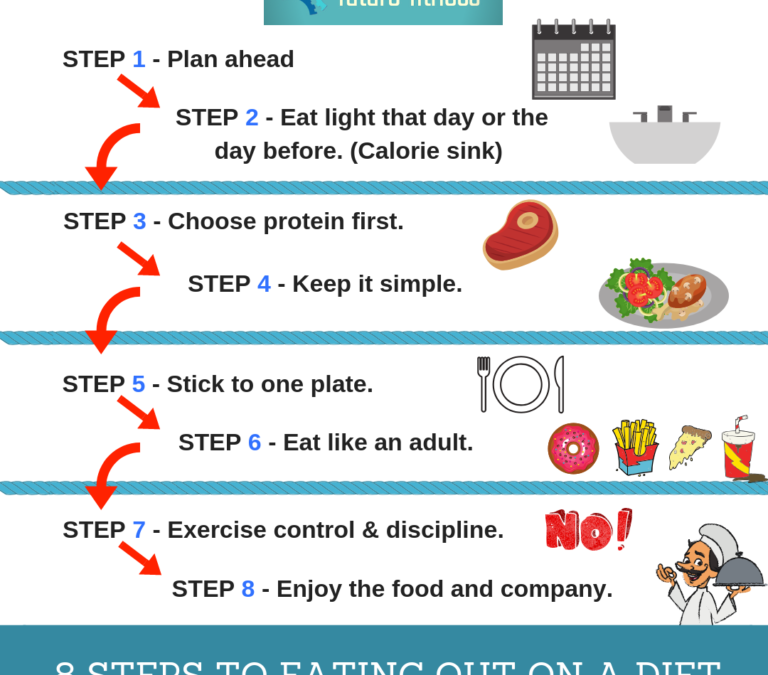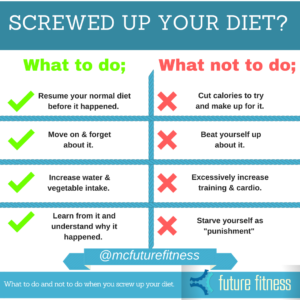When you are on a diet or trying to lose weight, it is always best to cook your own meals at home as you know exactly what is in them but that doesn’t mean you should never eat out again.
You can still eat out in restaurants from time to time and make great progress towards your goals.
You just need to be a bit mindful of your choices to keep you on track!
Eating out from time to time is a great way to relax, take a night off cooking and socialize with friends and family so it is really important to have a meal out here and there.
In this article, we have put together an eight step guide to help you make better choices in restaurants so that you won’t go too far off track.

1.) Plan ahead.
If you are going out for a meal, plan it in advance! It is way easier account for something if you have a plan in place.
When you don’t plan, it is a lot easier to end up overeating so put a plan in place and stick to it!!
Look up menus online beforehand. A lot of restaurants these days have all the nutritional info available online.
That way then you can have a look at the menu in advance and see what you can easily fit into your diet.
Choose a restaurant with low calorie options available. There are so many great places to eat these days with lighter options on the menu but if there isn’t you can always still work around it by making smarter choices.

(Nando’s Nutritional Info)
2.) Eat light that day (or in the days previous) to create a calorie sink.
Planning a meal out on Saturday? There are a few different ways of creating a calorie sink. One option could be reducing calories slightly in the few days before it. For example, reduce calories by 200-300 calories Wednesday, Thursday and Friday. That gives you an extra 600-900 calories for your meal out on Saturday and still will keep you in an overall deficit for the week.
Don’t reduce calories by any more than 200-300 though as it will leave you feeling hungry and irritable meaning it will be much harder to keep on track with your diet during the week with the likelihood of overeating/binging.
Another way of doing it is keeping calories light on the day of the meal out. If going out for dinner, have a light breakfast/lunch. If going out for breakfast, keep the rest of your meals light after it!
Have meals of a lean protein source and some fruit/veg keeping carbs and/or fats low to save them for the meal out. Some good examples include Greek yogurt and berries, a protein shake, chicken and veg stir fry (no rice), turkey burger and salad etc…
Whatever you do, don’t starve yourself all day to save calories for the meal out. Hungry people make bad decisions. That bread basket on the table will be wiped out before you even have a chance to look at the menu!
Having something about 30 minutes before hand just to kill your hunger will help you make better decisions. Something small like a protein shake! It will also help you fill up a bit quicker and prevent you from overeating.

3.) Choose protein first.
When ordering in a restaurant, try to order a dish which is high in protein for example a meat/fish dish. Protein is the most satiating of the three macronutrients so it is important to help you feel full for longer.
Some good leaner options include chicken breast, seafood, steak with fat trimmed etc.
Try to avoid breaded or battered options.
Try to choose methods of cooking such as grilling, boiling, barbecuing, steaming, baking, poaching etc. Pan frying or deep frying foods add in lots of extra calories from oils/butters.
If choosing a stir fry/pan fried option, ask the waiter/waitress if oil/butter can be reduced or left out completely from the dish. Don’t be afraid to make special requests! You are paying for the meal so the chef should be able to accommodate your needs.
Choose curries which are not coconut or cream based. Same with pasta dishes – opt for tomato based sauces over creamy/cheesy sauces.

4.) Keep it simple.
Choose more basic/simple dishes. That way it is much easier to track and have an idea of what exactly is in it. The less complicated a dish is and the less ingredients it has, the less calories it has in most cases e.g. grilled steak and a side of veg.
For example if ordering a salad, leave out high calorie items such as bacon, cheese, croutons.
When choosing carb sources, again keep them simple. Boiled rice or baked potatoes are much lower calorie options than chips, fried rice, mashed potato etc. If you are choosing higher calorie options, just have a smaller portion.

5.) Stick to one plate.
Portions in restaurants are usually very big!
Try to use the one plate rule and even at that, you don’t need to eat it all if the portion is very big.
You could even ask for half of it to go. Eat until you are satisfied, not stuffed and bring the rest home!!
Another option would be to ask for a half portion or a smaller portion so you won’t be tempted by having too much on your plate.
Eat slowly. Take your time. Chew your food! It can take around 20 minutes for your stomach to start signalling your brain that you are full so really take your time and enjoy the meal.
Fill up on protein and veg first. Keep your portion of carbs smaller or ask for extra veg instead rice/potatoes etc.
If ordering a pasta dish, ask for less pasta and extra veg.

6.) Eat like an adult.
I’m serious about this one!! Ordering chicken nuggets and chips is never a good option if you are trying to watch your figure. 😛
Eat your veg!!! And lots of it! Ask for an extra serving of veg with your meal and try opt for steamed to keep it as low calorie as possible.
Keep track of what you are eating and stick to what you had originally planned!! Don’t let something tempting throw you off.
Be smart about your choices!! Salad doesn’t always mean low calorie so read the menu carefully and make a good informed decision before ordering.
Drink lots of water with your meal and choose a calorie free drink/low calorie option. Don’t waste your calories on drinks!!
Try to avoid having alcohol with your meal. Alcohol will lower your inhibitions so it will be a lot harder to eat like an adult when you are faced with temptations. If you really want a drink, wait until after your meal!

7.) Exercise control and discipline.
Practice portion control. Use your good habits and routines to keep you on track. Sure you don’t know exactly what is in the food you are eating but you will have a rough idea of portion sizes to help keep you on track.
Try to limit it to having just one course or even at least keep one course really low calorie.
Some good starter options include broths/soup (skip the bread) or salads.
If you really want dessert, you could share one! Or at least choose a low calorie option such as a fruit plate or even one scoop of ice-cream. Practice restraint not restriction!
Get sauces/dressings on the side. Ask for lower calorie sauces/dressings such as balsamic vinegar, barbecue sauce, salsa, sriracha etc. rather than oily dressings, creamy dressings, cheesy sauces, mayo, garlic butter, guacamole etc.

8.) Enjoy the food and the company.
This is the most important one! Make sure you enjoy your meal and don’t feel guilty about your choices after if you do end up going a bit over board.
If you end up going a bit off plan, learn from it and move on!! Just get straight back on track with your next meal and put it behind you.
Whatever you do, don’t try to restrict calories or cut out anything from your diet to ‘make up’ for it. This encourages a negative relationship with food!! It is one meal!! If you are being consistent day to day and week to week with your diet, one meal isn’t going to make too much of a difference in the long term.


